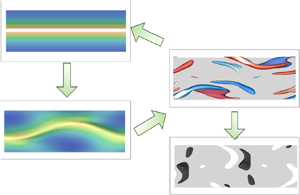Article contents
On the generation of near-wall dilatational motions in hypersonic turbulent boundary layers
Published online by Cambridge University Press: 04 April 2024
Abstract

Dilatational motions in the shape of travelling wave packets have been identified recently to be dynamically significant in hypersonic turbulent boundary layers. The present study investigates the mechanisms of their generation and their association with the solenoidal motions, especially the well-recognized near-wall self-sustaining process of the regeneration cycle between the velocity streaks and quasi-streamwise vortices. By exploiting the direct numerical simulation databases and orchestrating numerical experiments, we explore systematically the near-wall flow dynamics in the processes of the formation and transient growth of low-speed streaks. We conclude via theoretical ansatz that the nonlinearity related to the parallel density and pressure gradients close to the wall due to the restriction of the isothermal boundary condition is the primary cause of the generation of the dilatational structures at small scales. In fully developed turbulence, the formation and the existence of healthy dilatational travelling wave packets require the participation of the turbulence at scales larger than those of the near-wall regeneration cycles, especially the occurrence of the bursting events that generate vortex clusters. This is proven by the less intensified dilatational motions in the numerical experiments in which the Orr mechanism is alleviated and the vortical structures and turbulent bursts are weakened.
Information
- Type
- JFM Papers
- Information
- Copyright
- © The Author(s), 2024. Published by Cambridge University Press
References
- 11
- Cited by


